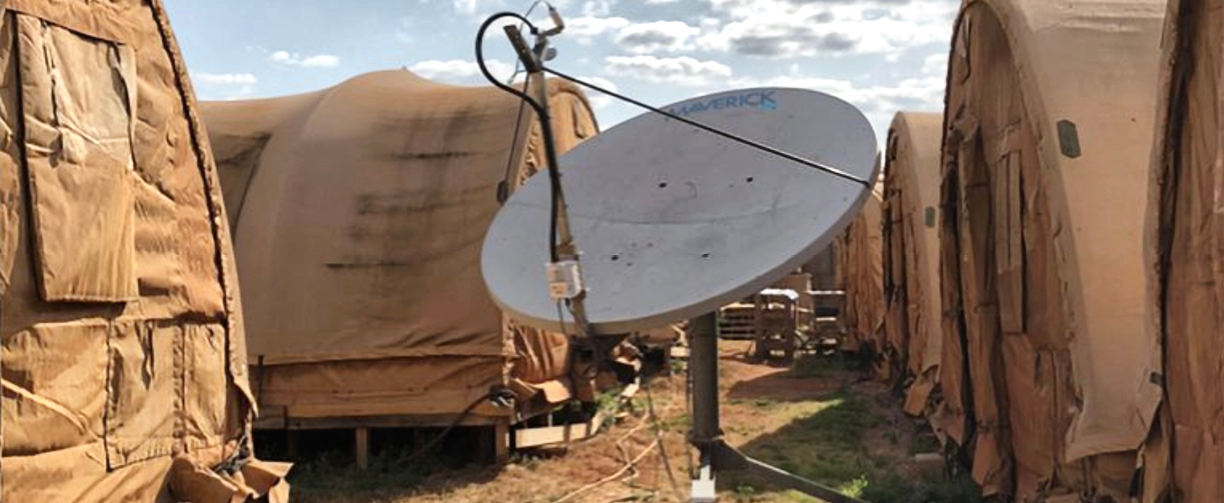Maintaining resilient and secure satellite communications is one of the most important capabilities needed by deployed warfighters, whether on land, at sea or in the air. The ability to communicate critical data can be achieved with secure satellite communications systems that are resilient to cyber-attack and deliberate or accidental jamming.

Having multiple data transport channels (e.g., multiple satellites, teleports, frequency bands, waveforms, and so on) can enable deployed forces to fight through contested or congested MILSATCOM environments. This approach offers various benefits across multiple MilGov applications.
This article will look at the benefits of a flexible terminal and the associated supporting MILSATCOM enterprise infrastructure as well as the requirements to successfully deploy this type of system in the field.
Improved Resiliency, Robustness, Flexibility and Manageability
In today’s cyberwar environment, the desire for multi-transport, flexible, terminal technologies are crucial for any successful, global mission. Whether the user is tasked with a defense- related mission or even a disaster response/first-responder reaction, critical communication solutions are imperative to the success of the mission and/or response. Multi-transport, flexible communication solutions will be necessary to ensure SATCOM links can survive to support mission-critical MILSATCOM services.
In the U.S. Department of Defense industry, the U.S. Space Force (USSF) released their “fighting SATCOM” operational vision in January 2020. Referring to the USSF SATCOM Vision, General John W. Raymond said, “Adversaries understand the advantage SATCOM brings our warfighters and are working to deny, degrade and destroy these capabilities. Despite the global, instantaneous reach of our SATCOM capabilities, which includes both military (MILSATCOM) and commercial (COMSATCOM) capabilities, the enterprise needs to improve its resiliency, robustness, flexibility and manageability.
“For the United States to maintain its asymmetric advantage of global space-based communications, the SATCOM enterprise must evolve quickly. We must prepare now to fight SATCOM as a single enterprise through a contested, degraded and operationally limited (CDO) environment, prevent or withstand loss, and continue to deliver effects to warfighters.
“The objective of the USSF’s SATCOM Enterprise Management and Control (EM&C) program is to ‘provide resilient, effective management and visualization of a heterogeneous enterprise SATCOM environment, including both MILSATCOM and COMSATCOM resources’.”
This capability will deliver significantly enhanced situational awareness across all MILSATCOM domains to provide leadership and operations personnel with the information they need to react to threats and initiate rapid recovery. An important part of the mitigation and recovery will be to enable deployed wideband MILSATCOM terminals to “roam” between satellites and networks very rapidly.
This is particularly true for commercial SATCOM services that do not have the inherent protections that purpose- built MILSATCOM systems provide. The EM&C program will also develop open standards for use by the industry and the government to enable rapid integration of the capabilities into terminal modernization and development efforts, making it widely and promptly available to DOD users.
In the near future, the EM&C program will comprise of several application suites and tools including Situational Awareness, Terminal Registry, Service Provider Registry, Service Planning, Service Orchestrations, Security Management and a Data Warehouse. The EM&C architecture is evolving as prototype systems are developed in an agile manner, bringing the functional and data requirements and workflows features into clear focus.
The application suites mentioned above will allow for ease of forecasting and planning, MILSATCOM resource allocation, terminal provisioning, terminal activation and network acquisition, monitoring, all contributing to and benefiting from a comprehensive situational awareness capability.
These application suites are envisioned. Prototypes are being developed for some of this at this time under USSF sponsorship.
Forecasting and Planning — The military leadership for a particular mission or set of missions, engaged with COMSATCOM satellite and services providers, uses a variety of planning and resource allocation tools and processes available within the enterprise to develop specific configurations of carriers and/ or managed network service requirements needed to fulfill the mission’s MILSATCOM communications requirements. These requirements can also include several contingent carriers and potential network accesses that represent possible surge solutions, and/or provide solutions to address potential loss of satellite resources as the result of failures or attacks (i.e., a SATCOM PACE plan).
SATCOM Resource Allocation — This process allocates resources available from the various SATCOM Service Providers to specific terminals, appropriate to the terminal capabilities, mission roles and priorities. The output of this is a set of Service Configuration Packages (SCPs) for each terminal, enabling its access to its allocated networks. This process enables strategic load balancing and contingency planning to mitigate network attacks or failures. A full suite of SCPs represents a machine- readable PACE plan for a given terminal.
Terminal Provisioning — SCPs are loaded into a database within the Terminal Manager (TM). The TM is a software application that can be hosted on a small micro-server integrated with the terminal.
Terminals already equipped with a control computer may be able to host the TM software on the existing compute platform.
The initial SCPs can be loaded prior to deployment, and then continuously updated via secure network communications between the Terminal Manager and Regional/Theater Network Element Managers anytime the terminal is online using the Flexible Terminal Interface (FTI). The FTI is a messaging protocol that provides two-way, M&C communication between the Terminal Manager and the local Network Element Manager. This allows rapid reallocation of MILSATCOM resources to address evolving battlefield requirements.
Terminal Activation/Network Acquisition — Terminal operators acting under appropriate command authority activate one of the carriers or network accesses available in the terminal’s SCP library. The User Interface (UI) provided by the Terminal Manager makes this a simple selection from a menu. In response to this selection, the Terminal Manager accesses its database of SCPs and loads the corresponding data into each manageable device (e.g., ACU, modem, router) within the terminal. This loading is performed automatically by the Terminal Manager. Once all terminal device configurations are complete and the Terminal Manager verifies their correctness, the TM proceeds with acquisition of the desired carrier or managed network.
Once the terminal is successfully online and passing wideband IP traffic, the TM uses the FTI M&C link to receive SCP updates, and for the Terminal Manager periodically to provide terminal status and network performance/ utilization data visible from its perspective in the network. This provides a rich set of real-time status, performance and use data to the Situational Awareness element.
Situational Awareness — Real-time data feeds are provided from a variety of sources to populate displays and feed data analytics functions. These capabilities provide commanders and operators at various echelons the information they need to make informed command decisions and react appropriately to threats or system failures.
Advantages OF Satcom Enterprise M&C Architecture
Enables SATCOM Roaming
Easy, rapid movement between different networks, satellites and service providers brings significantly improved resilience of SATCOM operations to a broad spectrum of impairments, providing reduced mission vulnerability to EMI/RFI, satellite/network failure, congestion and cyber-attack.
Improved Mission Effectiveness
Access to other networks enables rapid response to changing mission requirements including throughput, geographical reach, look angle restrictions, etc.
Improved MILSATCOM Resource Efficiency
With EM&C-enabled MILSATCOM, network stovepipes are eliminated, and resource pools can be managed for load balancing and surge support.
Provides Full End-to-End Network Situational Awareness
This reduces time to address network failures or attacks, provides objective measures of system performance and informs future planning and resource allocation for future missions.
Provides Enhanced Support to Tactical Terminal Operators
This includes faster terminal service acquisition and troubleshooting by terminal operators, as well as a reduction in training requirements. It also enables remote support by expert SMEs shared across all terminals in a region or theater.
Delivers Enhanced Logistics and CM/QC Support for Sustainability
Real-time terminal asset management and configuration management are provided with terminal status reporting.
Cost-Effective
The proposed approach is very economical to implement relative to any alternative.
Timely and Low-risk
The proposed approach can be deployed quickly and accrue large benefits in the near-term to meet immediate needs. It is very amenable to spiral development and deployment.
Summary
An integrated MILSATCOM M&C enterprise will deliver unparalleled options to joint warfighters for mission success. Enhanced performance and resilience are necessary to address a 21st century contested space domain.


Chad Gatlin
Dave Meadows
We must move faster than our adversaries to ensure warfighters receive the operational benefits of a SATCOM enterprise capable of delivering MILSATCOM effects in CDO environments. We must adopt faster acquisition processes and faster command and control constructs to maintain the advantage in any conflict.
www.networkinv.com
Authors: Chad Gatlin, Chief Executive Officer, and Dave Meadows, Division Vice President, Advanced Programs, NIC4


